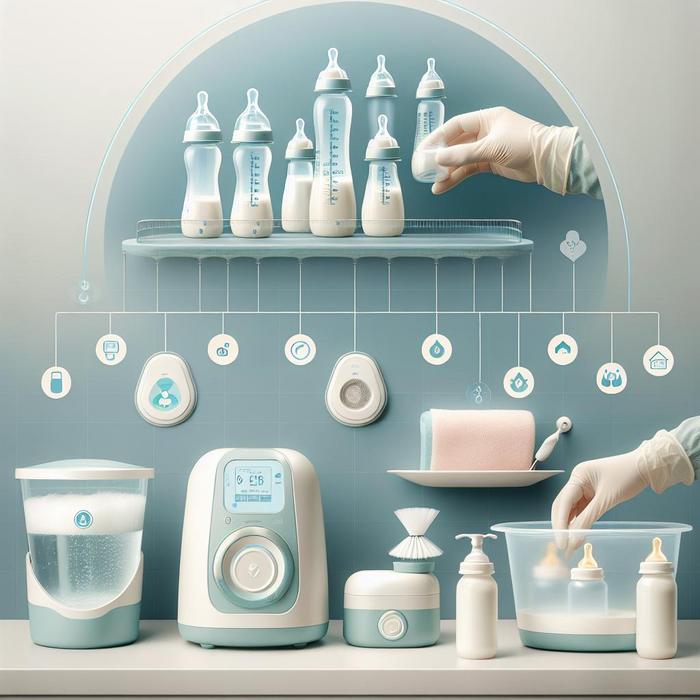Optimizing Feeding Safety with the Right Bottle Choice
Feeding newborns and infants requires utmost care and safety precautions. One of the crucial steps towards secure baby feeding is the selection of suitable feeding bottles. This post will guide you to ensure feeding safety by choosing the safest baby bottles.
The Importance of Secure Baby Feeding
Proper baby feeding goes beyond mere nutrition; it is about ensuring your baby’s safety and promoting healthy growth. The wrong bottle choice could lead to problems like colic, gas, and even nipple confusion in breastfed babies. This contradicts the primary aim of feeding, which is the health and optimal development of your baby.
Tips for Choosing the Safest Feeding Bottles
There are a myriad of options available for baby bottles, each with its unique features. This section outlines vital tips to guide you in making a safe choice.
- Material: The material of the bottle can significantly affect feeding safety. Preeminent options include glass, plastic, and stainless steel. Each has its pros and cons, which are essential to consider. For instance, glass bottles are easy to sterilize and BPA-free, but they are also heavier and can break.
- Bottle Design: The design of the bottle should be comfortable and easy for the baby to grip. Additionally, bottles with a wide neck are easier to clean, reducing the risk of bacterial build-up.
- Nipple Shape and Flow: The bottle nipple’s shape and flow can significantly affect feeding safety and comfort. Experts recommend a slow flow nipple, especially for breastfed babies, to avoid overfeeding and minimize the risk of choking. The nipple shape should mimic the feel and flow of a mother’s breast to prevent nipple confusion. Here’s an insightful guide on the best slow-flow bottles for breastfed babies.
- BPA-Free: Bisphenol A (BPA) can cause several health issues, so it’s essential to choose BPA-free feeding bottles. This Mayo Clinic guide on infant formula elucidates more on this.
Additional Safety Measures for Secure Baby Feeding
In addition, to choosing the safest baby bottles, it’s important to take further steps to ensure feeding safety. Here are some additional recommendations:
- Cleaning and Sterilization: Regular cleaning and sterilization of baby bottles prevent the growth of bacteria and other pathogens. A thorough guide on giving the bottle correctly shares more on this topic.
- Proper Handling: Always hold the bottle at an angle that lets the formula, or breast milk fill the nipple. This guide on bottle-feeding nutrition and safety illustrates this.
- Balanced Breastfeeding and Bottle-Feeding: For breastfeeding moms who occasionally bottle-feed, maintaining a balance is crucial to preventing nipple confusion. Here are some tips for a smooth bottle-feeding transition.
Choosing the Safe Baby Bottles: Tips and Recommendations
The process of choosing a safe baby bottle requires careful consideration and thoughtful approach. Below, we break the process down into manageable chunks and provide actionable, evidence-backed advice to aid your decision:
- Consider the Material: Glass, plastic, and stainless steel are popular materials for baby bottles. While plastic bottles are lightweight and unbreakable, they may contain BPA unless labeled as BPA-free. Stainless steel bottles, on the other hand, are durable and safe but can be expensive. Glass bottles are chemical-free and can maintain heat longer, though they’re hefty and breakable.
- Examine the Design: The design of the bottle affects your baby’s comfort and safety. Bottles with a wide neck are easier to clean and thus keep bacteria at bay. The design should also enable the baby to grip the bottle securely.
- Focus on the Nipple Shape and Flow: The shape of a bottle’s nipple and the speed at which milk flows out is paramount. Experts advise using a slow flow nipple to prevent overfeeding and choking. Consider a nipple shape that emulates a mother’s breast to eliminate nipple confusion in breastfed babies.
- Emphasize BPA-Free: A BPA-free bottle is a safer choice since BPA can cause multiple health problems. For more information, check out this comprehensive bottle-feeding advice by NHS.
Maintaining Bottle and Feeding Safety
Even after selecting the safest baby bottle, consider the following additional measures to further enhance feeding safety:
- Clean and Sterilize Regularly: Regular cleaning and sterilizing of baby bottles are crucial preventing the proliferation of harmful bacteria. This resourceful guideline by CDC provides detailed insights on properly handling baby bottles.
- Handle Properly: Always hold the bottle at an angle that allows the milk to fill the nipple. This helps prevent the baby from ingesting air, which can cause discomfort. This comprehensive guide by HealthyChildren.org offers a plethora of tips on safe bottle handling.
- Balanced Breastfeeding and Bottle-Feeding: If you are a breastfeeding mom who also bottle-feeds, maintaining balance is essential to avoid nipple confusion. Comment on this piece for some unique tips by CDC to assist in finding this balance.
Conclusion
Remember, there is no one-size-fits-all when it comes to choosing the right baby bottle, but by considering these parameters mentioned above, you can rest assured that you are making a safer choice for your baby. Your baby’s health and safety are always paramount, so always take the time to select and maintain your baby feeding time and gears wisely.

